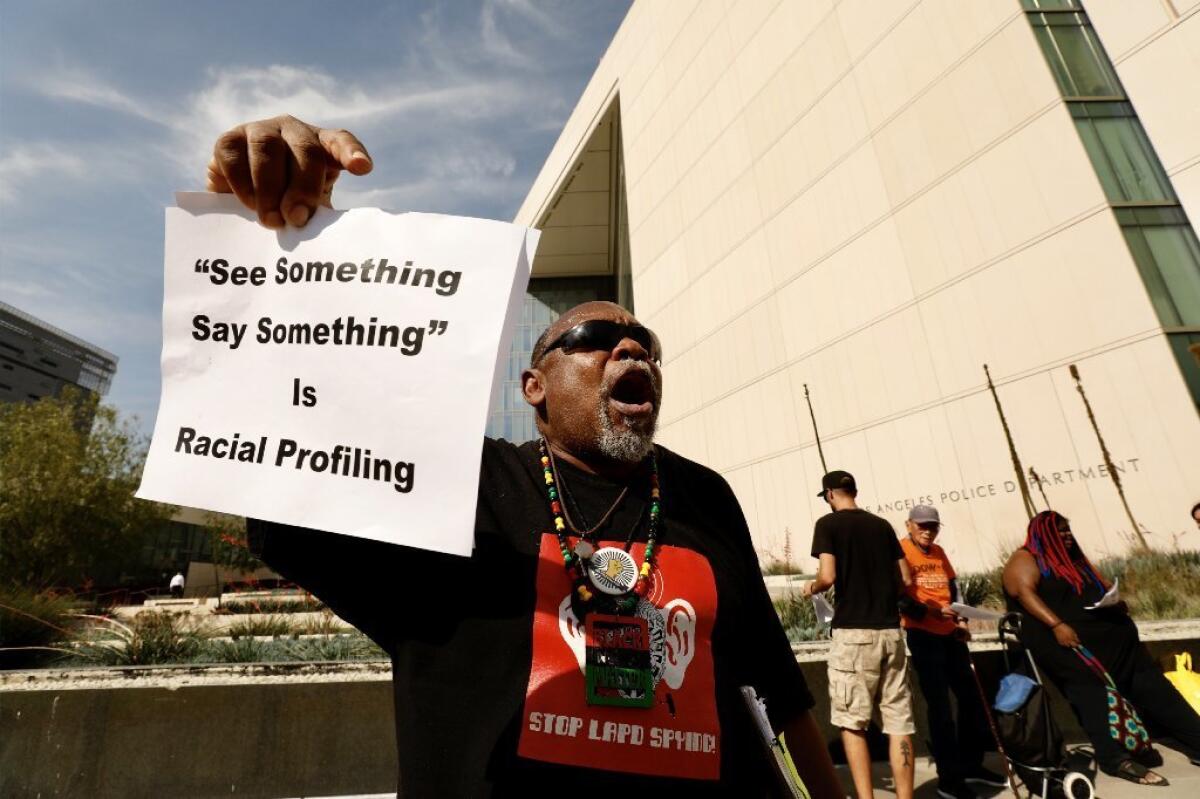Commissioners and critics question LAPD’s reports on suspected terrorist activity

- Share via
Critics of a Los Angeles Police Department program that identifies potential terrorist activities called for it to be dismantled Tuesday, complaining that people of some races and ethnicities are unfairly targeted.
An audit from the Police Commission’s inspector general said the LAPD mostly followed correct policy in classifying 348 reports of suspicious activity filed by community members and police in 2016 and 2017. But two dozen critics turned out at a meeting of the panel, many holding signs denouncing the program.
While the audit contained few criticisms of the reporting program, Inspector General Mark P. Smith determined that the LAPD should update some policies, including better identification of the race of people suspected of suspicious activity by either police or the public. That issue also drew scrutiny from some commission members.
“What are the protections against abuses?” Commissioner Dale Bonner asked. “What protections, if any, are in place?”
Tuesday’s complaints come after the LAPD already ended two controversial data policing programs in April, when several commissioners and activists said they unfairly targeted minorities and weren’t effective in identifying locations of guns and gang violence.
Police Chief Michel Moore said the department plans to “untangle” how individuals reported for suspicious activity are identified.
“We’re trying to determine if a crime is being contemplated ,” Moore said. “It’s the behavior we’re looking at. It’s already controversial.”
In a post-9/11 world, the program encourages people to alert police of anything that seems out of place. It is supposed to be based on a set of specific behaviors, such as storing unusual quantities of chemicals or taking photos of people performing security functions at government buildings. The federal government established a nationwide collaborative more than a decade ago for law enforcement at all levels of government to share information to prevent terrorism.
The suspicious activity report or SAR form is available online or through a telephone hotline and can be submitted anonymously. It asks tipsters to describe, among other things, what they saw and to identify the suspect if possible.
Reports are sent to the LAPD’s Major Crimes Division, where officers conduct follow-up investigations to assess the possibility of a threat. If they conclude there is merit to the report, the information is sent to a Joint Regional Intelligence Center for further vetting and, if needed, investigation by federal authorities.
The audit concluded that 98% of the reports were properly classified. But half originated from people taking photographs in public — not stockpiling guns or buying materials for bombs.
Overall, the public initiated 293 reports and police 55. After reviewing the reports, the LAPD determined 176 were unfounded and the remaining 172 indicated behavior that could suggest planning related to terrorism or other criminal activity. The intelligence center accepted 95 reports.
Race was identified in 164 reports. Of those, Latinos represented 30% and blacks 21% — which is more than twice the share of African Americans in the city. Predominantly white areas policed by the Valley and West bureaus accounted for 60% of all reports.
Bonner and Commissioner Eileen Decker pressed Moore and members of the command staff to explain how the department measures results of the program. Both commissioners also raised questions about the safeguards to protect against racial biases. They also requested a second discussion to focus on policy and results, not process.
Moore acknowledged the department needs to do a better job of “articulating the outcomes” and offered to provide commissioners classified information in closed-door briefings. He cautioned that results cannot be measured by numbers, but said the program has led to arrests and thwarted potential terrorism acts. He did not provide details.
“What we don’t want people to do is not report something and regret it later,” said Deputy Chief Horace Frank, head of the Counter-Terrorism and Special Operations Bureau.
One fault the audit found was how police and the public identified the people they reported. In about a quarter of all reports, an individual’s descent was labeled as “other,” rather than given a specific racial category. After examining case notes, auditors found many of those individuals had Middle Eastern roots.
While policy says race, ethnicity or national origin should not be used to create suspicions, the inspector general urged the department to better identify the people because of “community concerns” about racial profiling.
Tipsters identify individuals based on perception and “that is a problem,” Frank told commissioners, noting there is no consistency in the identifications.
Activists who crowded the meeting cited the audit’s finding that 51% of the reports were unfounded, and said the program wastes money and is ineffective.
Nearly every speaker said police use the tool to create secret files on people and that white residents in affluent areas use anonymous complaints to target Latinos and African Americans.
“What we have today is spin,” said Hamid Khan, a coordinator with Stop LAPD Spying Coalition, which has been battling the LAPD for years over how it uses data to fight crime. “This is a license to racially profile.”
An elderly man added: “This whole program needs to be shut down. This has so much secrecy in it.”
More to Read
Sign up for Essential California
The most important California stories and recommendations in your inbox every morning.
You may occasionally receive promotional content from the Los Angeles Times.














